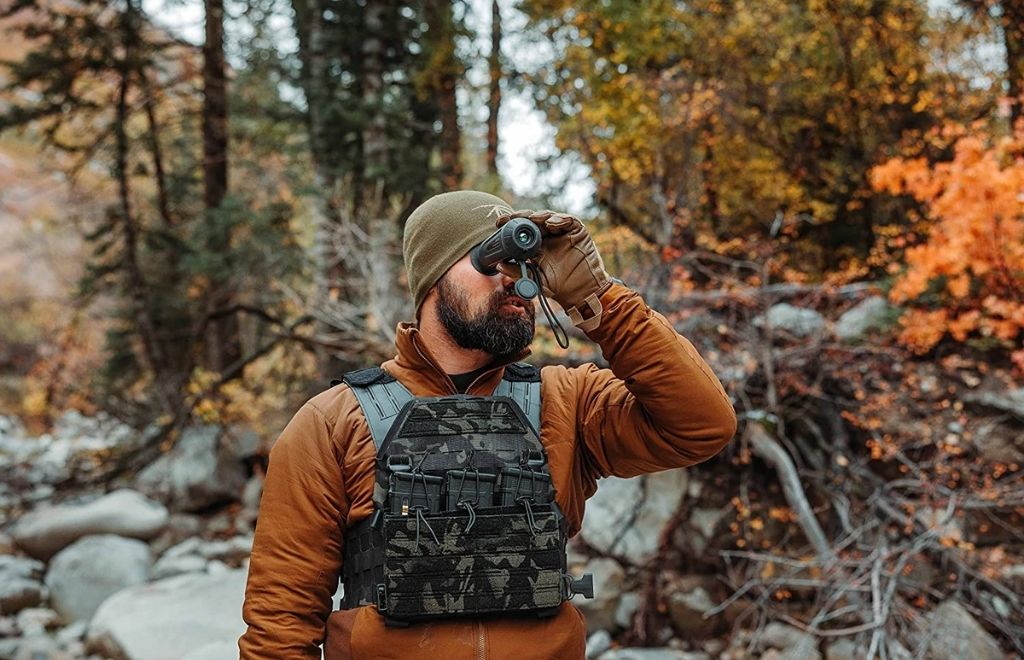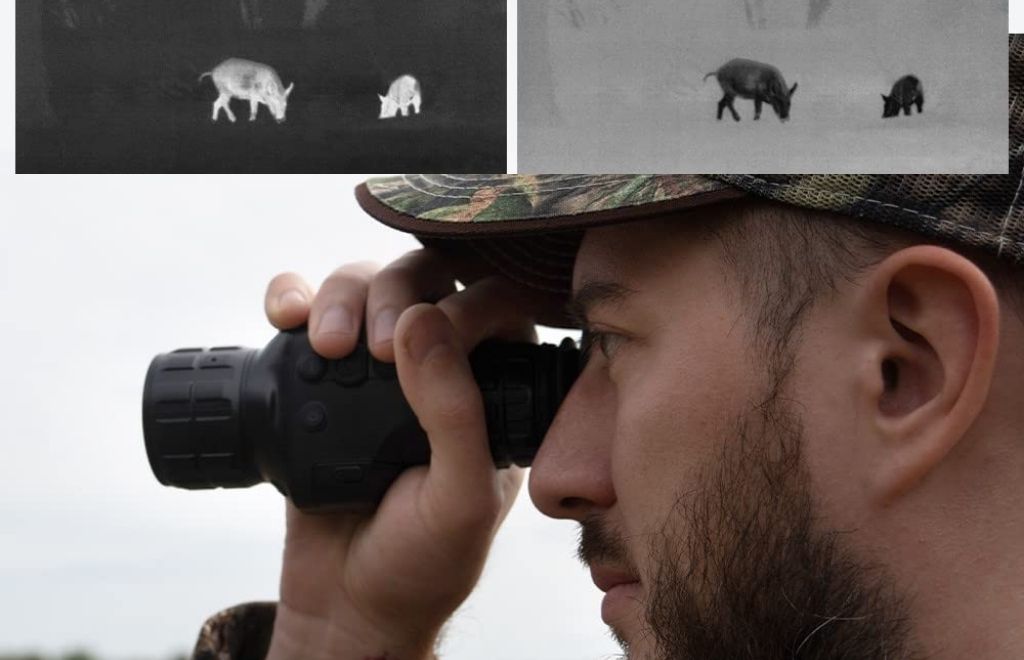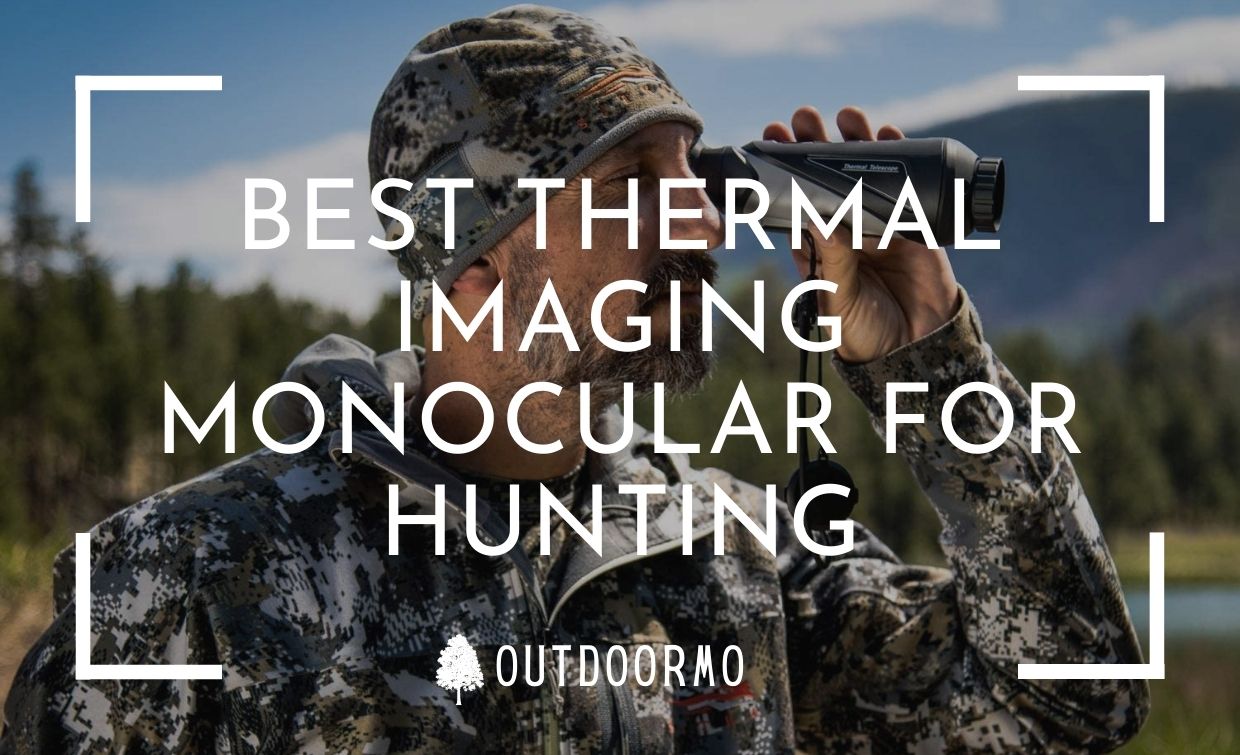Hunting can be an expensive hobby. It often requires the purchase of many different tools so that you will have a better and more efficient experience in the field.
Such tools include your gear, clothing, as well as tree stands if you want higher elevation. But a tool that any hunter must-have is a vision-aiding device. This could be in the form of a monocular or binocular, depending on your preferences.
In this article, we will take a look at some of the best thermal monocular for hunting. I will lay out all that I have learned up until now, thanks to a great deal of hunt experience.
By the end, you will have a clear idea of which one to purchase on your next visit to the gear shop. Not only that, but I will also give important tips to help you in your search of the best thermal monoculars on the market.
*The product links in this post are affiliate links, which means that if you purchase after following one, I make a small commission from the sale at no additional cost to yourself. Please see our disclosure page for more information.
Top Picks





Features to look for in a great hunting thermal imaging monocular

Before any of your thermal vision monocular purchases, there is a need to know several features that will determine whether it is worth the buy or not. This is necessary especially for hunters who love to go coyote hunting and hog hunting but do not want to engage in multiple purchases during their hobby.
Also, it ensures that your thermal imaging monocular will be flexible and long-lasting, even to future holders.
Working Conditions
What is meant by a working condition? The answer is simple. These are the optimal scenarios in which a thermal imaging monocular works, meaning that no interference will happen.
This is important to know so that users will not be shocked at why their thermal monoculars is not functioning properly.
There are some good working conditions for a handheld thermal monoculars are nighttime as well as places where there is a clear difference in temperatures, for example; using a thermal imager at night will be beneficial since the contrast of the subject against the environment is vivid thereby detecting heat signatures easily.
Similar to conventional cameras, thermal cameras capture and translate infrared light, which is invisible to the human eye, into an image that can be read.
A clear example of this is spotting a deer in the forest. Since the forest is cold and a deer is warm-blooded, a hunter will detect it easily, thanks to the thermal technology of these devices.
Clarity and Thermal Sensor Resolution
Clarity and resolution are crucial features when choosing a hunting device. As for why, I have a great explanation. But before that, we should learn the meaning behind the words in terms of thermal monoculars.
Clarity refers to how vivid a thermal image quality produced by the whole system is, despite the elements present in front of it. It also matters greatly when viewing objects from a long distance. Some thermal monoculars that have a low quality will produce thermal images with lower clarity, meaning that what is in the real world won’t be reflected by the system.
On the other hand, the resolution is defined by how many pixels will be produced by the thermal monocular. The higher the resolution, the better the thermal image quality will be. It is safe to think that thermal monoculars that have a higher resolution need to have high-end lenses and better processing power.
Not only that, but they must also have exceptional raw materials as well as builds so that the system can compensate for the quality. In this field, it is needed to have high-quality binoculars. Thus, it is always recommended to invest in a quality handheld thermal monocular rather than be stingy since it will benefit you in the long run.
Processor
A thermal imaging monocular requires some processing power since it has to convert thermal data into light or visible data.
This is done by sensing infrared radiation or thermal heat signature in an object and relating it to the radiation of the surroundings. With the resulting heat map, the temperature differences are laid out, and a user can easily see everything and hot track a target even without the presence of light.
For this reason, a good monocular needs sufficient thermal technology computing power to function properly. If this is not satisfied, then the result would be a system that will not have enough juice to unveil the environment.
Not only that but special thermal devices and sensors are necessary such as cryogenic coolers and radiation identifiers.
Real-Life Application
What good is a thermal monocular if you cant apply it to your hunting activities? A buyer should always be wary of the limitations of a product like a handheld thermal monocular so that it will be properly used in the field.
For example, one must guarantee that the monocular is not too bulky or even heavy to use as it removes the portability of the thermal device. Furthermore, it should also be durable and able to withstand accidents so that it will last for a long time.
This is the part where price plays a fairly huge part and answers the question; are thermal scopes worth the money? After all, a cheap monocular will never have the same capabilities and usability compared to an expensive one. As a seasoned hunter and gear enthusiast, I will always say that it is better to invest in costly gear rather than to spend money on a cheap one.
6 Best Thermal Imaging Monocular For Hunting
Here are some of the best thermal imaging monoculars you can use for hunting that are currently on the market.
1. Zeiss DTI 3/25 & DTI 3/35 Thermal Imaging Night Vision High-Resolution High-Precision Monocular Cameras for Hunting

The Zeiss DTI 3/25 and 3/35 are built optimally for one thing: pure hunting. It packs various features that you will surely enjoy, thanks also to the company that produces it. If you are not aware, ZEISS is an international optical and optoelectronic company that has made its name in the industry. It is a proven and tested organization in terms of binoculars and thermal monoculars.
What sets this product apart from others? Well, it has been equipped with the best features that a modern monocular can have. Since its release in March 2020, enthusiasts have fawned over this device.
After all, it has a High Definition LCOS display that delivers sharp images with professional quality even during the absence of light. Furthermore, the tracking of the system is exceptional even at a long distance of up to 1200 meters and packed with a high refresh rate.
Some good features of the Zeiss DTI 3/5 include:
Contrast Improvement. Worried that temperature differences will not be displayed correctly during harsh weather? No need to be! The Zeiss DTI 3/25 and 35 have a powerful contrast enhancement program that increases the saturation between light and dark elements. This means that it works perfectly for heat detection even during stormy or rainy weather!
Long Battery Life. Every hunter knows how annoying it is to stop the hunt just because of failed vision due to a depleted battery. It’s so frustrating and maddening at the same time! Luckily, the DTI 3/25 and 35 are equipped with around 10 hours of long lasting battery life which is more than enough not just for two or three, but four hunts!
Live Stream of the Hunt. Want to share your adventure with the world? This is more than possible with the Zeiss monocular! Make use of the live streaming app via WLAN or Wi-Fi to share the live feed of the hunt with your followers. This gives the device a very modernistic way of social media presence.
Ergonomics. The main selling point of the Zeiss is that it is designed for hand-held usage. Scientists of the company ensured that your palm, carpals, and fingers are taken into account every time you use this product.

- Value for the money
- Great Fit on the Hand
- Social Media Integration
- Ambidextrous

- Low Spec Quality
- Not the Best Zeiss Product
2. FLIR Scion Thermal Imaging Monocular

The FLIR Scion Thermal Imaging Monocular is in a league of its own. It has numerous features that greatly help not only in hunting but also in various fields such as security, surveillance, and tracking. It comes in two packages: 9 and 60 Hz.
This means that one can choose based on their budget without fear of not getting the value out of their money.
Another great thing that the FLIR Scion offers is its great display resolution. With working pixels rated at around 640X480, a hunter can see its prey over a long impressive range using this device.
Pair this with the endurance and durability of the casing, and you get a thermal monocular that can last for years to come.
Some good features of the FLIR Scion include:
Modern User Interface. Teledyne, the company that created the FLIR Scion, has ensured that it is equipped with the best software possible. This includes streamlining the User Interface of the camera to easily view features and buttons that relate to the optimal functioning of the device. Access is added for picture-zoom, one-button recording, and geo-tracking.
Fool-proof Thermal Detector. When it comes to thermal detection of heat signature, the FLIR Scion is a strong one. With the help of the Boson thermal core which allows cooled operations even when processing information, less radiation noise is seen by the thermal sensor tools. Not only that but the OLED or Organic Light Emitting Diode aids in vivid thermal viewing outputs and images despite harsh weather conditions.
Bluetooth and Geotagging. How do Bluetooth and Geotagging help in thermal monoculars? Well. Bluetooth has applications in device tracking as well as pairing with accessories. Not only that, but geotagging puts a location description on recorded images and live feed meaning that you can track where your hunt transpired.
Streaming and Recording. Another great feature of the FLIR Scion is that it is similar to the ATN OTS HD 384, and I love its capability to record and stream the actual output. This allows for reviewing the activity or routine so that you can improve on your steps for the next time. Overall, it provides a good balance of durability and digital twin creation.

- Durable
- Value for Money
- Great Distance Measurement
- Clear Contrasts

- Zoom Pixelation Issues
- Expensive
3. AGM Global Vision Thermal Monocular Asp TM35-640

The AGM Global Vision Thermal Monocular is one of the best in terms of balance in price and usability. After all, it features heavy-duty capabilities despite not having a high price point.
This night vision monocular is simple to use, intuitive, and beginner-friendly while still having optimal operations suitable for high-end hunts. With a 640×512 resolution and infrared detector displayed on a 1024×768 OLED display, you can be assured that you will spot hidden prey as it moves.
The Asp TM35-640 is simply perfect for all types of night-hunt including coyote or hog hunting. Not only does it improve your night vision, but it also has added applications in terms of law enforcement, search and rescue, patrols, and even surveillance. This makes it a very versatile device that is not one-sided.
Some good features of the AMD Global Vision include:
Distance Gauge. What sets the Asp TM35-640 apart from other thermal monoculars is its capability of measuring distances just with the power of infrared radiation. This happens with the aid of the measurement function that marks the top and bottom fields of a subject. After marking, one will know related coordinates and dimensions concerning the target.
Wi-Fi Connectivity. Wi-Fi connectivity of any thermal monocular device helps in storing information and capturing a live feed of the surroundings in real-time. Not only that, but the included app can also set the general parameters of the camera remotely.
Hotspots. What is a hotspot? It is an area that produces an exceptional amount of heat when compared to the rest of its body. For this reason, it is a clear indication that a living subject is in front of your lens. The ASP TM35-640 marks hotspots of the highest temperature and pairs them with palette switching for enhancement.
Digital Zoom. Is the target too far from you? NO need to worry as this device allows up to 8x of digital zoom. This zoom is even usable in extreme darkness, and this adds benefits to all your nighttime activities.

- Durable
- Internal Recording
- Wi-Fi Streaming
- Hotspot Contrasts

- Not the best in terms of shape
- Limited Warranty
4. FLIR Scout TK Handheld Thermal Imaging Devices

When it comes to a budget and quality thermal imaging device, the FLIR Scout TK Handheld is one of the best out there. The price is leagues below its competitors, but it still functions amazingly as an entry-level hunting equipment.
Users can’t get enough of this product, evident in the hundreds of positive reviews that it has online. Despite its build which looks like a mini-missile, it has very powerful features that can help you with night vision when hunting at night.
Furthermore, the resolution of 160 x 120 in terms of high-end cameras might be small, but it is understandable due to its low price. But, you will not have trouble with viewing far away and longer distances as it is compensated by its 640×480 LCD Display.
The field of view is something to respect, as it has a wide 20 degrees by 16 degrees. Furthermore, the detection range is around 100 yards, making it versatile.
Some good features of the FLIR Scout include:
Portability and Weight. The major selling point of the FLIR Scout TK is its weight and handheld design. A hunter will not have any difficulty in using this monocular no matter how heavy his gear is due to the comfort that it brings. Not only that but you can even fit it in your vest’s jacket for maximum space-saving.
Ready-to-use. Tired of those delays in powering up your thermal cameras? Well, there’s nothing to worry about since such issues don’t exist with the FLIR! It only requires a couple of seconds to ready up, and even beginners will not have a hard time using it. This is due to the simple four-button design as well as the user-friendly interface that it has.
Color Palettes. One feature that I like the most about the FLIR is its capability to show many different video palettes. These include white hot, black hot, instant alert, and graded fire. Such choices will provide benefits on your hunt since you can adjust your mode accordingly. Furthermore, the contrast between the subject and surroundings is enough to compensate for the low resolution.

- Inexpensive
- Easy to Use
- Lightweight
- Clear photos

- Warranty does not cover battery
- Refunding Issues
5. AGM Global Vision Thermal monocular Taipan TM25-384

The AGM Global Vision Taipan TM25-384 can be seen as the brother of the ASP TM-35 model. They come from the same company, so it is only normal that they’d have very similar features.
To start, the device is rated at 12 Microns with a large 384×288 thermal sensor resolution which is displayed on a 1280×960 pixels LCOS display. This is on the higher end of the spectrum for thermal monoculars, and this explains the price point.
Other advanced features of the product include a WiFi hotspot, onboard recording, as well a memory module. Not only that, but the shape looks amazing and menacing for a thermal monocular.
One of the things I love the most about this product is its grip, paired with the four-main buttons. It works in a way that you won’t strain your hand while navigating through the system. Also, it prevents the device from slipping from your palm.
Some good features of the AGM Global Vision include:
Distance Gauge and Estimation. Distance gauge and estimation refer to the device’s ability to calculate the distance of the target from yours. This is very helpful during hunts, as it helps set settings for your bow and rifle so that you won’t miss your next shot. Not only that, but it also can gauge subject height by selecting two points.
Contrasts of Colors. Thermal imaging cameras are very useless if it can not see the temperature differences. The sensors play a huge part in this, but the processor and software of the monocular also have a significant effect. With this in mind, the AGM TM25-384 is equipped with various color palettes such as black and white hots, reds, as well as various spectrums. This will help in distinguishing the foreground and the background.
Red Zones with Large Display. Red zones, or hotspots, are particularly hot surfaces detected by the thermal camera. These are usually present in animals’ skins, mouths, or faces. Thus, when a red zone or hotspot appears in the display, it is also a confirmation that life is present in that area. Couple this with the large display of the device, and you have a very intuitive device.

- Hotspots
- Best in Streaming
- Great Colors
- Distinguish the Subject

- Price Issues
- Charging Problems
6. Pulsar Helion 2 Thermal Monocular

The Pulsar Helion 2, in my take, is one of the coolest-looking thermal monoculars in the market. Just judging from its design, it looks straight out of a sci-fi movie.
However, looks are not the only thing that is amazing about this device. The features are hefty, and one can enjoy the full benefits of a thermal imager when utilizing it.
It has a high thermal sensitivity with a whopping 50 Hz high refresh rate. Not only that, but the supply runs up to 8 hrs in a single charge. Also, its IPX7 rating means that it can withstand being submerged in water for some time.
Here are other features of the device:
Rangefinder. Want to know the size of the hunt that you are against? Well, the device has a very intuitive range finder that uses a stadiometer to operate. This means that you can get precise heights and distances of a given object as long as it is in your lens.
Remote control. Navigate and operate your device with the power of Wi-Fi and Bluetooth. The Pulsar Helion also has an integrated application to greatly help with the different features that it has. You can even Livestream your entire adventure with just a click!
Image Frequency. Image frequency refers to the refresh rate of the monocular. Think of it as frames per second in a movie or a video game. A game that has higher FPS will look smoother, dynamic, and fluid. On the other hand, those with lower ones will appear to be clunky and rugged. This thermal monocular has a total refresh rate of 50 Hz, meaning that it refreshes 50 times per second, resulting in comfortable viewing.
Custom Colors and Contrasts. The Pulsar Helion has a total of 8 different color modes ranging from whites, blacks, heat, and colds. This will help a user determine the best type of contrast for the situation and gain a better advantage in the field. Not only that, but the color palettes match with the developed heat map for better coverage.

- Best Clarity
- Great Magnification
- Ergonomic
- Wi-Fi Streaming

- Restocking Roadblocks
- Refund Issues
Buyer Guide & FAQs
What to look for in thermal imaging monoculars
Good Clarity. This refers to the final output of the thermal imager to the display. As much as possible, get a monocular that is known for having sharp image quality as well as good contrast. This will help determine the target apart from the surroundings better.
Great Magnification. Never neglect one of the main purposes on why you are buying a thermal monocular. Be wary of products that display that they have large zoom optical magnification range and values but the result is still blurry and pixelated.
User Interface. What does a user interface refer to? Well, it is the design of the navigable software. This part of the device will always make or break the overall feel. This is because a thermal monocular with tons of good features will be useless if the user interface will not be easy to understand. The same is true the other way around.
Egonomics. Ergonomics refers to the human comfort aspect of the device. This includes things such as the grip, strain, as well as muscle pain that it brings especially in long usage durations. A good thermal monocular must take these into account and have a build that is easy to grasp and carry around. Not only that, but the buttons on top of the camera must be reachable by the fingers that are free during the portability tests. If such conditions are satisfied, then it is deemed to be an ergonomic monocular.

Different types of thermal imaging
Scopes. Night vision scopes are great add-ons to your guns or rifles that are helpful with night vision when doing night hunting especially in total darkness. Thermal imager scopes are a bit smaller than your regular thermal monoculars, but they still offer the same base functionality. However, due to their size, some features might be different or toned down. Despite this limitation, the thermal imager scope is still a favorite amongst hunting enthusiasts due to its versatility.
Binoculars. A binocular can be seen as two monoculars paired up with each other. This means that you will be able to view both from the left and right eye. Binoculars are great in terms of comfort as they reduce eyestrain which comes from unequal magnification viewing. Furthermore, they are better suited for long hunts.
Key points for consideration before buying?
Before buying thermal imaging monoculars for hunting, you must first decide if you want an entry-level, mid-range, or high-end device. With this category as your guide, you will know if the value of your purchase is equal to the efficiency.
For starters or beginners, it is usually recommended to purchase a thermal monocular for beginners just so they can get a hang of how things work. As time passes by, they can then switch to a more expensive model with more features compared to the basic ones.
Another key consideration to think of is the preferred time of the hunt. Thermal imagers work well during night and day, but daytime operations might have a stark difference, this is due to the increased environmental temperature that can mess up the readings as well as the resulting heat map.
Lastly, there is a need to do a background check of the company that you will be purchasing from. You do not want to end up getting scammed for your money just because you were not careful. Some known manufacturers in the field include LEICA and FLIR. By following this guide, you will never go wrong with your purchase.

FAQs
Is thermal or night vision better for coyote hunting?
Both products have their strengths and weaknesses. However, thermal imagers are passive and do not rely on a light source and this makes them better at night. On the other hand, for tactical situations where you need to see detail to maintain situational awareness, night vision is a preferable option. Night vision scopes relies on the ambient light source to function. If none is present in the surroundings, then an infrared light emitter will be utilized.
Can you use thermal imaging for hunting?
Absolutely! One of the main purposes of having a thermal imager monocular is hunting. These devices are especially helpful for night vision due to their capabilities in viewing areas without the need for any illumination.
Are thermal optics illegal?
Yes, thermal optics are very legal. They are even used in law enforcement and security.
Can thermal see-through bush?
A thermal imager can see through the bush provided that there is a subject with a higher temperature behind the bush. The imager will display the heat map of the creature and you will have full thermal vision.
What is the life expectancy of a thermal scope?
Thermal scopes, with proper care, should last for 5 years or more. These include proper maintenance, cleaning, and even check-ups.
Final Thoughts
Now that you know about my top picks, it is time for you to choose yours as well. Personally, my best choice is the FLIR Scout since it fits me perfectly as someone who wants fast skirmishes and comfy carries.
No matter what you choose, you should always have the advantage in night vision hunting when using a thermal monocular. Take care of your device through proper maintenance and preventive measures to avoid component deterioration.
Remember to enjoy your new gear and be safe during your activity!

